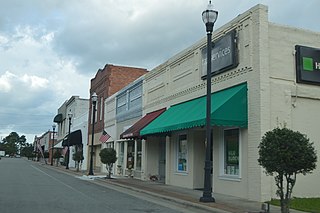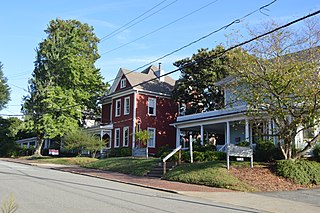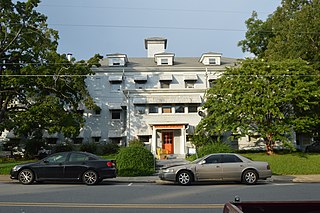
Halifax Historic District is a national historic district located at Halifax, Halifax County, North Carolina, US that was listed on the National Register of Historic Places in 1970. It includes several buildings that are individually listed on the National Register. Halifax was the site of the signing of the Halifax Resolves on April 12, 1776, a set of resolutions of the North Carolina Provincial Congress which led to the United States Declaration of Independence gaining the support of North Carolina's delegates to the Second Continental Congress in that year.

Smithfield Historic District is a national historic district located at Smithfield, Isle of Wight County, Virginia. It encompasses 289 contributing buildings and 2 contributing structures in the historic downtown and surrounding residential areas of Smithfield. There are 211 houses, 37 commercial buildings, 1 warehouse, 4 churches, 10 barns, 1 smokehouse, 23 garages, 1 farm office, 1 colonial kitchen, and 2 corncrib structures. Notable buildings include the original county clerk's office (1799), county jail, Wentworth-Barrett House, Wentworth–Grinnan House, King-Atkinson House, Smith-Morrison House (1770s), Hayden Hall, Boykin House, Goodrich House (1886), Thomas House (1889), Smithfield Academy (1827), Christ Episcopal Church, and Hill Street Baptist Church (1923). Located in the district and separately listed are the Old Isle of Wight Courthouse, Smithfield Inn, Windsor Castle Farm, and P. D. Gwaltney Jr. House.

Graham Historic District is a national historic district located at Graham, Alamance County, North Carolina. It encompasses 72 contributing buildings and 1 contributing structure in the central business district of Graham. The district includes a variety of institutional, commercial, and residential buildings largely dating from the 19th century. Notable buildings include the Alamance County Courthouse, the centerpiece of the district; Graham Presbyterian Church; Harden House; Hunter House; Nicks Store; McBride Holt House ; Scott Building ; Vestal Hotel; Holt-Scott General·Store ; National Bank of Alamance ; Mont-White Theatre; and Paris Building.

Southport Historic District is a national historic district located at Southport, Brunswick County, North Carolina. The district encompasses 161 contributing buildings, 3 contributing sites, and 1 contributing object. Over half of the structures in the historic district date from the 1885-1905 period. It includes residential, commercial, and institutional buildings and is considered the best example of a Victorian coastal town in North Carolina. Notable buildings include the River Pilots Tower and Building (1940s), Frying Pan Lightship, Fort Johnston Officers Quarters, Walker-Pike House, Brunswick Inn, Fort Johnston Hospital, Former Brunswick County Court House, Saint Philips Episcopal Church, Trinity Methodist Church (1888-1890), and the Adkins-Ruark House (1890).
Mount Vernon Springs Historic District is a national historic district located near Bonlee, Chatham County, North Carolina. The district encompasses 23 contributing buildings, 3 contributing sites, and 7 contributing structures in the rural village of Mount Vernon Springs. The village grew up near a locally famous mineral spring. Notable buildings include the Greek Revival style Female Dormitory of the Baptist Academy (1855), Gothic Revival style Mt. Vernon Springs Presbyterian Church (1885), the John C. Kirkman House, Robert P. Johnson House, and John M. Foust House. Also located in the district are the Mt. Vernon Springs, the Baptist Academy Cemetery, and the Mt. Vernon Springs Presbyterian Church cemetery.

Warsaw Historic District is a national historic district located at Warsaw, Duplin County, North Carolina. The district encompasses 55 contributing buildings and 1 contributing structure in the central business district and surrounding residential area of Warsaw. It includes residential and commercial buildings with notable examples of Queen Anne and Classical Revival style architecture. Notable buildings include the Warsaw Inn (1909), Barden Hotel, Kennedy-Middleton House (1885), L.P. Best House (1894), Henry L. Stevens House (1897), and Warsaw Presbyterian Church (1884).

Holly Avenue Historic District is a national historic district located at Winston-Salem, Forsyth County, North Carolina. The district encompasses 115 contributing buildings and 1 contributing site in a predominantly residential section of Winston-Salem. The buildings date between about 1885 and 1952, and include single family dwellings and apartment building. The include examples of late-19th and early-20th popular architectural styles including the Queen Anne and Italianate style. Notable buildings include the Henry Case House, James Jessup House, Henry Foltz bam (1906), Calvary Moravian Church (1923), T. R. Brann's store, and Green Front Grocery.

Academy Hill Historic District is a national historic district located at Statesville, Iredell County, North Carolina. It encompasses 40 contributing buildings in a mixed-use neighborhood of Statesville. The district includes notable examples of Late Victorian architecture including primarily brick educational and industrial buildings and one and two-story frame dwellings. They were mainly built between 1885 and 1930. Notable buildings include the former Statesville Male Academy (1874), Statesville Graded School (1892), J. C. Steele & Sons Brick Machinery Plant, Ash Tobacco Factory, O. W. Slane Glass Company, J. C. Steele House (1880s), C. M. Steele House (1901), H. Oscar Steele House, and William E. Webb House.

East Broad Street–Davie Avenue Historic District is a national historic district located at Statesville, Iredell County, North Carolina. It encompasses 65 contributing buildings in a predominantly residential section of Statesville. The district includes notable examples of Late Victorian architecture and were mainly built between about 1880 and 1930. Notable buildings include the Elma Apartments building, Matt-Simons House, J. S. Ramsey House, and Major H. L. Allison House.
Mitchell College Historic District is a national historic district located at Statesville, Iredell County, North Carolina. It encompasses 336 contributing buildings and 1 contributing site associated with Mitchell Community College and the surrounding residential area in Statesville. The district includes notable examples of Greek Revival, Queen Anne, and Classical Revival architecture dated between about 1885 and 1930. Located in the district is the oldest building and separately listed; the Main Building, Mitchell College (1854-1856). Other notable contributing resources are the Fourth Creek Burying Ground, George Anderson House, Friends Meeting House, Broad St. Methodist Church (1907), Congregation Emmanuel Synagogue (1891), McRorie House, Dr. Tom H. Anderson House, Dr. Julius Lowenstein House, Ludwig Ash House, L. N. Mills House (1925), Mills Apartment, R. A. Cooper House (1920), Statesville Woman's Club (1927), and the former Davis Hospital.

Downtown Smithfield Historic District is a national historic district located at Smithfield, Johnston County, North Carolina. It encompasses 24 contributing buildings in the central business district of Smithfield. It includes notable examples of Classical Revival and Art Deco style architecture and buildings dating from about the 1890s through the 1930s. Located in the district is the separately listed Hood Brothers Building. Other notable buildings include the Austin Building (1921), First Citizens Bank (1913), Carolina Telephone Building (1913), Municipal Building (1937), and the Howell Theater (1935).

Brooklyn Historic District is a national historic district located at Smithfield, Johnston County, North Carolina. It encompasses 88 contributing buildings in a predominantly residential section of Smithfield. It includes notable examples of Queen Anne style architecture and buildings dating from about the 1870s through the 1940s. Located in the district is the separately listed Hood-Strickland House. Other notable buildings include the Smithfield Elementary School (1912-1913), the Smithfield Steam Laundry, Woodall-Fleming House, Davis-Boyette House (1889), Ellington-Holland House, Willis Henry Austin House (1912), Dr. Thel Hooks House (1916), and Ragsdale-McLemore House (1922).

Lee Avenue Historic District is a national historic district located at Sanford, Lee County, North Carolina. It encompasses 70 contributing buildings in the historic village of Jonesboro, now part of Sanford. The district includes notable examples of Bungalow / American Craftsman style architecture, with buildings largely dated between about 1882 to the 1940s. Notable buildings include the Pierce-Seawell House, Barnes House, Jonesboro Methodist Church Parsonage, Lonnie Thomas House (1941), and Jonesboro Baptist Church (1950).

Mitchelltown Historic District is a national historic district located at Kinston, Lenoir County, North Carolina. It encompasses 204 contributing buildings in a predominantly residential section of Kinston. The buildings include notable examples of Colonial Revival, Classical Revival, and Bungalow / American Craftsman style architecture and date between 1885 and 1941. Notable buildings include the Adolphus Mitchell House, W. A. Mitchell House, Luther P. Tapp House, H. B. W. Canady House, and Robert B. Scott Bouse.
Masonboro Sound Historic District is a national historic district located near Wilmington, New Hanover County, North Carolina. The district encompasses 22 contributing buildings, 2 contributing sites, 8 contributing structures, and 1 contributing object near Wilmington. The district developed during the 19th and early-20th century and includes notable examples of Italian Renaissance and Colonial Revival style architecture. There are 10 contributing dwellings and 13 contributing outbuildings. Notable dwellings include the Carr-Ormand House (1932), Willard-Sprunt-Woolvin House (1880), Cazaux-Williams-Crow House, Parsley-Love House, Live Oaks (1913), Taylor-Bissinger House (1937), the "Doll House" (1924), and Hill-Anderson Cottage.
Burgaw Historic District is a national historic district located at Burgaw, Pender County, North Carolina. The district encompasses 130 contributing buildings, 1 contributing structure, and 1 contributing object in the central business district and surrounding residential sections of Burgaw. The district developed from the mid-19th to mid-20th century, and includes notable examples of Gothic Revival and Queen Anne style architecture. Located in the district are the separately listed Burgaw Depot and Pender County Courthouse. Other notable contributing buildings include the M. M. Moore House, Murphy-Sasser House, Dr. H. B. Thomas House, Burton-Noel House (1917), Burgaw Presbyterian Church, Macedonia African Methodist Episcopal (AME) Church, Burgaw Methodist Church (1928), the Burgaw Baptist Church (1948), Bank of Pender (1907), Pender County Jail (1924), and R.H. Holland Motor Company Building (1924).

Liberty Historic District is a national historic district located at Liberty, Randolph County, North Carolina, United States.The district encompasses 48 contributing buildings and 2 contributing structures in the central business district and surrounding residential sections of Liberty. It includes buildings built between about 1880 to about 1950 and notable examples of Queen Anne and Colonial Revival architecture. Notable buildings include the Liberty Depot, Reitzel Building, the Farmer's Union Mercantile Co. Building, the Curtis Theater (1949), Bob Patterson House, the A.J. Patterson House, the Bascom M. and Alpha L. Brower House, J.C. Luther House, the Clarence Kennedy House (1940), and Hardin's Florist.

Central Leaksville Historic District is a national historic district located at Eden, Rockingham County, North Carolina. It encompasses 67 contributing buildings, 2 contributing sites, and 1 contributing object in a residential section of the town of Eden. It was developed from about 1815 to about 1935, and includes notable examples of Italianate, Queen Anne, Colonial Revival, and Bungalow style architecture. Notable buildings include the Rogers-Martin-Taylor House, Saunders-Hege House, Robinson-Dillard-Martin House, Lawson-Moir-Clayton House, Episcopal Church of the Epiphany (1844), J. M. Hopper House (1885), Norman-DeHart House, and Casteen House.

The Waxhaw Historic District is a national historic district located at Waxhaw, Union County, North Carolina. It encompasses 93 contributing buildings, 3 contributing structures, and 1 contributing object in the central business district and surrounding residential sections of Waxhaw. The district developed between about 1888 and 1940 and includes notable examples of Commercial Style, Queen Anne, and Bungalow / American Craftsman style architecture. Notable buildings include the former Post Office (1905), Harris's store, Tyson Store, A.W. Heath Co. Mill (1905), R.J. Belk Company Store, A.W. Heath Company Stores, Weir Building, Plyler Building, Farmer's Ginning & Trading Company, McDonald Hotel (1912), Waxhaw Presbyterian Church (1929), Duncan McDonald House, and Ralph J. Belk House.

Plymouth Historic District is a national historic district located in Plymouth, Washington County, North Carolina. The district encompasses 258 contributing buildings, 5 contributing sites, and 1 contributing structure in the central business district and surrounding residential sections of Plymouth. It was largely developed between about 1880 and 1930 and includes notable examples of Colonial Revival, Bungalow / American Craftsman and Late Victorian style architecture. Located in the district are the separately listed Latham House, Perry-Spruill House, and Washington County Courthouse. Other notable buildings include the Hornthal-Owens Building, Blount Building, Atlantic Coast Line Railroad Station (1923), Davenport-Davis House, Robert Ward Johnston House (1924), Latham-Brinkley House (1883), Plymouth United Methodist Church and Cemetery, Grace Episcopal Church and Cemetery designed by Richard Upjohn, New Chapel Baptist Church (1924), Agricultural Building (1936-1937) constructed through the Works Progress Administration, Plvmouth Railroad Station (1927), Brinkley Commercial Block (1926), and Clark-Chesson House.



















